January 09, 2023
Lake Mills is a community that’s ready for growth
Member Utilities
This article was first published by MEUW in the Live Lines newsletter, Volume 72, Issue 1.
Lake Mills is growing. Steadily.
Thirty years ago, the city was home to over 4,000 residents. Today, that number is over 6,000 and rising. According to Paul Hermanson, director of public works with Lake Mills Light & Water, the city has plenty of room left to continue that growth.
Situated along the section of I-94 that connects Madison and Milwaukee, most of Lake Mills, including the downtown, is south of the interstate. However, the city also includes a large swath of undeveloped land north of the interstate.
Over the past couple years, Lake Mills has become home to many new apartments and condos, and a recently completed suburb just added another 120 homes to the area.
“We have the space to expand,” shared Hermanson. “We’re looking at controlled growth, and we’re ready for it.”
Leading the charge is the locally owned, not-for-profit utility. Lake Mills Light & Water is busy getting lines in and keeping up with the demand required of a growing city while continuing to plan for the future. Hermanson is currently working with utility staff and the city to design a new $50 million wastewater treatment plant.
With so many new buildings coming to the area, the utility is also busy educating city officials and builders. One apartment complex was interested in installing 51 electric vehicle chargers in anticipation of future needs. After speaking with the utility, the owner chose to set up the wiring to be able to accommodate chargers, but held off on the actual installations. Working together at this early stage saved the owner money and gave the utility time to continue preparing for the increased electric load.
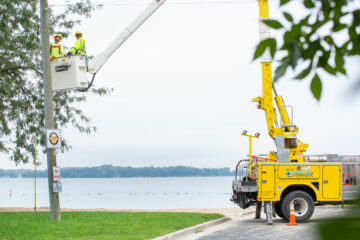 The utility built a new substation ten years ago and has more than enough capacity for the growing city. While capacity isn’t an issue, time and money can be. The utility is also in the midst of switching over to advanced metering infrastructure (AMI). With 75% of electric meters and 40% of water meters switched over, Lake Mills is experiencing the same supply chain issues impacting the rest of the nation.
The utility built a new substation ten years ago and has more than enough capacity for the growing city. While capacity isn’t an issue, time and money can be. The utility is also in the midst of switching over to advanced metering infrastructure (AMI). With 75% of electric meters and 40% of water meters switched over, Lake Mills is experiencing the same supply chain issues impacting the rest of the nation.
“Luckily,” shares Hermanson, “we work quite nicely with our neighbors.”
Hermanson is alluding to Jefferson, Oconomowoc, Waterloo, and other like-minded, public power utilities in the vicinity. The utilities work with one another to share necessary utility equipment when in need, which has become more important during the ongoing supply chain issues.
Greg Hoffmann, energy services manager for Lake Mills Light & Water, understands the importance of relationships and he puts in the effort to foster them. He recently held a lunch at the steakhouse Hi-Way Harry’s in Johnson Creek. Gathered together were a group of local utility managers and lead lineworkers, with the united purpose of getting and staying acquainted so they feel comfortable calling on one another when in need.
Not just relegated to meters and transformers, the utilities also stand in for one another when low on another valued resource — employees.
Over Opening Weekend in Wisconsin, the lineworkers in Lake Mills all took time off to go hunting. Thanks to the close relationships cultivated by the works of Hoffmann, Hermanson, and others, the city prepared ahead of time and knew it was well-equipped via the nearby utilities should any need arise.
As Hoffmann so perfectly summed up, “It’s all about relationships.”
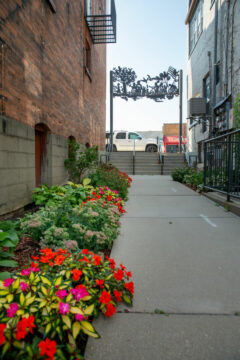 Hermanson also describes the situation as a common theme he’s seeing in today’s workforce. “New employees are no longer changing to match the utility; we have to change to match them.”
Hermanson also describes the situation as a common theme he’s seeing in today’s workforce. “New employees are no longer changing to match the utility; we have to change to match them.”
The city employs seven staff members in the streets department, three in wastewater, three in water, four in electric, and another three employees who float between the departments. The utility is currently searching for a meter tech to join the team.
For now, Lake Mills Light & Water is relying on its joint action agency, WPPI Energy, to fulfill its meter tech duties.
“This is public power,” says Hermanson. “We rely on our public power neighbors to help with parts shortages, we’ve been using WPPI Energy’s meter tech program while we search for our next meter tech, and MEUW has been invaluable for our safety training. OSHA made a visit the other day, and we were completely ready without much prep. Being a part of MEUW and WPPI really positions us for success, especially for a utility of our size.”
“If those systems weren’t in place, it would be a different situation altogether. And not a good one.”
Fortunately, the utility finds itself in a safe and stable spot, even as it continues to search for a new employee during a labor market that is favoring employees. As a municipal utility, Lake Mills Light & Water stands out from other local employers. It boasts of great benefits, a family-oriented culture, and the desire to encourage employees to enjoy the community.
And apparently, the community has a lot to enjoy.
Lake Mills hosts the Lake Mills Triathlon each summer as part of the Wisconsin Tri Series, an annual set of seven races held during the spring and summer months. The race takes advantage of Lake Mills’ Sandy Beach along Rock Lake for its swim portion of the race, before participants head to the country for the biking section and back to the city for the run.
Another popular race is the Tyranena Beer Run Half Marathon, which saw 1,400 participants in November of 2022. The race begins and ends at Tyranena Brewing Company.
Tyranena Brewing Company and Sunshine Brewing Company both call Lake Mills home, along with the Lewis Station Winery, a craft winery producing hand-crafted wines and a farm-to-table food menu. Complementing the winery and two breweries is a small-batch, dog-friendly distillery known as the Dog and Shrub Distillery. The distillery happens to be in Lake Mills Light & Water’s backyard.
Close to Bartel’s Beach, another beloved beach on Rock Lake, is the Pyramid Event Venue. A boutique performance and event space, Pyramid opened the summer of 2020 during the pandemic and now features pizza, cocktails, and local brews on the menu.
The James J. Chocolate Shop provides “the finest in old-fashioned candy-making,” with all of the chocolates and candies made by hand right in Lake Mills. Even the nutmeats are roasted using the shop’s small batch, copper kettle technique.
The Lake Mills School District encompasses an elementary, middle, and high school. Highlighting the city’s focus on the environment, Lake Mills Elementary School was the first K-12 school in the nation to achieve a LEED Platinum certification.
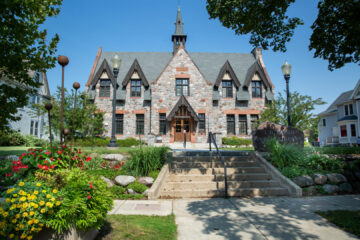 The lake, beaches, and wildlife areas all attract visitors and new residents to the community. The abundance of opportunities for outdoor activities includes kayaking, fishing, hunting, hiking and more.
The lake, beaches, and wildlife areas all attract visitors and new residents to the community. The abundance of opportunities for outdoor activities includes kayaking, fishing, hunting, hiking and more.
For the less outdoorsy individuals, Lake Mills hosts concerts for the community downtown, along with outdoor movies, skating, and other “Norman Rockwell stuff,” as Hoffmann referred to it.
Hermanson agrees, saying, “It’s an ideal place.”
The historic downtown has a little something for everyone. Antique stores, jewelry stores, restaurants and a coffee shop are all within walking distance. L.D. Fargo Public Library, named after Lorenzo Dow Fargo who made a gift of $5,000 to build the library in 1899, is designed in the Neogothic Revival Style and makes an impression on anyone who takes the time to visit.
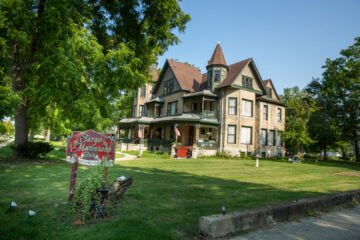 Leading to the downtown area is Mulberry Street, the initial thoroughfare from the city’s early days. The historic area is home to many grand residences, including the Fargo Mansion Inn. Innkeepers Tom and Barry have owned the bed and breakfast for over three decades, and even helped found the Wisconsin Bed and Breakfast Association.
Leading to the downtown area is Mulberry Street, the initial thoroughfare from the city’s early days. The historic area is home to many grand residences, including the Fargo Mansion Inn. Innkeepers Tom and Barry have owned the bed and breakfast for over three decades, and even helped found the Wisconsin Bed and Breakfast Association.
Helping keep history alive is the Lake Mills Aztalan Historical Society. The Lake Mills Aztalan Historical Society is headquartered in an old Baptist church built in 1852 by pioneer settlers. The historical society has resided in the building since 1942 and hosts a museum that is open on Saturdays and Sundays.
Lake Mills Light & Water is part of the city’s rich history and has been powering the community since 1911. Not only supplying residents and local businesses with electricity, the utility also supports the area in its actions.
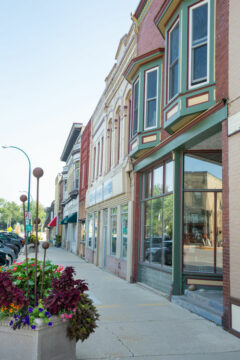 The utility hosts a toy drive during Public Power Week in October, donates turkeys in November, and helps light up the downtown holiday tree in December. Scholarships are awarded to local students in the spring, and the work of the utility never stops.
The utility hosts a toy drive during Public Power Week in October, donates turkeys in November, and helps light up the downtown holiday tree in December. Scholarships are awarded to local students in the spring, and the work of the utility never stops.
Hermanson says it all comes down to the utility doing what it can to serve the community. The utility’s efforts appear to be working, as Lake Mills is clearly thriving.
As new residents pour into the city, it’s easy to speculate what is pulling them in and it appears to be a mix of many perks. A beautiful natural area, the clear lake, a strong sense of history, a flourishing downtown, an invested community, a prime location just 25 miles east of Madison and 55 miles west of Milwaukee, virtually no crime, excellent schools, and a utility ready and prepared to embrace its newest residents.
